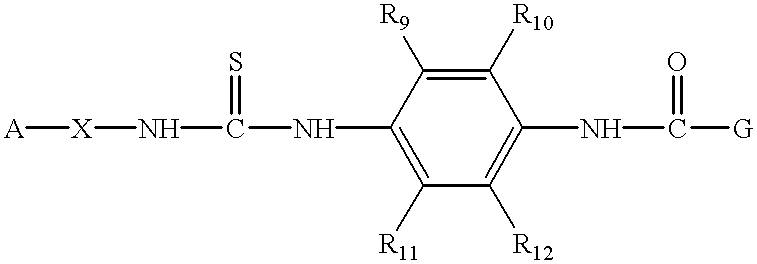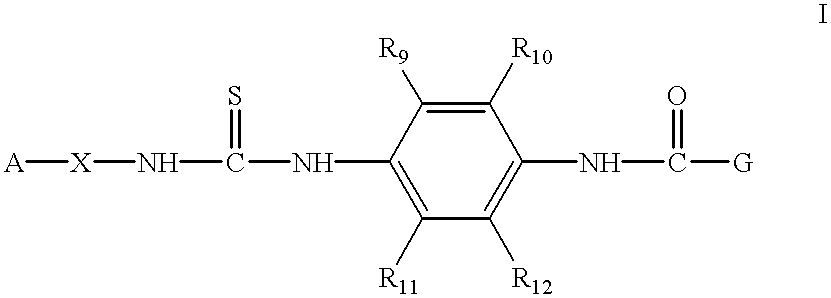Aminopyridine-containing thiourea inhibitors of herpes viruses
- Summary
- Abstract
- Description
- Claims
- Application Information
AI Technical Summary
Problems solved by technology
Method used
Image
Examples
example 1
(Method 1A)
4-Methoxy-3-trifluoromethyl-phenylamine
A suspension of 4-methoxy-3-trifluoromethyl-nitrobenzene (2.2 g) and iron powder (1.68 g) in ethanol (35 mL) and water (15 mL) is treated with a solution of concentrated hydrochloric acid (0.42 mL) in ethanol (6 mL) and water (3 mL) and the mixture is heated to reflux for approximately 1 hour. The mixture is then cooled, filtered, and concentrated under reduced pressure. The resulting oil is dissolved in ethyl acetate and extracted three times with 5% aqueous hydrochloric acid. The pooled acidic extracts are then cooled in an ice bath and basified with solid potassium carbonate, then extracted with ethyl acetate. These organic extracts are washed with saturated aqueous sodium chloride, dried over anhydrous sodium sulfate, concentrated under reduced pressure, then passed through a short column of silica gel (ethyl acetate is used as the eluant) to provide the desired compound as an amber oil.
Using the above procedure and appropriate s...
example 2
(Method 1B)
4-Bromo-2,4-dimethoxy-phenylamine
A suspension of 4-bromo-2,4-dimethoxy-nitrobenzene (0.48 g) and iron powder (0.42 g) in acetic acid (10 mL) and ethanol (10 mL) is heated to 120.degree. C. for approximately 5 hours. The mixture is then cooled, filtered, and concentrated under reduced pressure. Water is added and the mixture is cooled in an ice bath and neutralized with solid potassium carbonate and then extracted with dichloromethane. These organic extracts are washed with saturated aqueous sodium chloride, dried over anhydrous sodium sulfate, concentrated under reduced pressure, then chromatographed over silica gel (20% ethyl acetate in hexanes is used as the eluant) to provide the desired compound as an amber oil.
example 3
(Method 1C)
(4-Amino-2,6-dichloro-phenoxy)-acetic Acid Tert-butyl Ester
A soution of (4-nitro-2,6-dichloro-phenoxy)-acetic acid tert-butyl ester (1 g) in ethanol (17 mL) and water (8.6 mL) is treated with iron powder (0.861 g) and ammonium chloride (86 mg) and the mixture is heated to reflux for approximately 1 hour. The mixture is then filtered and concentrated under reduced pressure. The resulting oil is partitioned between water and ethyl acetate, and the organic phase is then washed with saturated aqueous sodium chloride, dried over anhydrous sodium sulfate, and concentrated under reduced pressure to provide the desired compound as a pale yellow solid.
Using the above procedure and appropriate starting materials the following compounds were prepared:
N-(4-Amino-2-chloro-phenyl)-acetamide
(4-Amino-2,6-dichloro-phenoxy)-acetonitrile
(4-Amino-2,6-dichloro-phenoxy)-acetic acid tert-butyl ester
(2-Amino-4-chloro-5-methoxy-phenoxy)-acetonitrile
(4-Amino-2-chloro-5-...
PUM
| Property | Measurement | Unit |
|---|---|---|
| Composition | aaaaa | aaaaa |
| Pharmaceutically acceptable | aaaaa | aaaaa |
| Bond | aaaaa | aaaaa |
Abstract
Description
Claims
Application Information
 Login to View More
Login to View More - R&D
- Intellectual Property
- Life Sciences
- Materials
- Tech Scout
- Unparalleled Data Quality
- Higher Quality Content
- 60% Fewer Hallucinations
Browse by: Latest US Patents, China's latest patents, Technical Efficacy Thesaurus, Application Domain, Technology Topic, Popular Technical Reports.
© 2025 PatSnap. All rights reserved.Legal|Privacy policy|Modern Slavery Act Transparency Statement|Sitemap|About US| Contact US: help@patsnap.com



